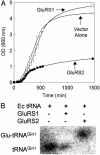A noncognate aminoacyl-tRNA synthetase that may resolve a missing link in protein evolution
- PMID: 13679580
- PMCID: PMC208751
- DOI: 10.1073/pnas.1932482100
A noncognate aminoacyl-tRNA synthetase that may resolve a missing link in protein evolution
Abstract
Efforts to delineate the advent of many enzymes essential to protein translation are often limited by the fact that the modern genetic code evolved before divergence of the tree of life. Glutaminyl-tRNA synthetase (GlnRS) is one noteworthy exception to the universality of the translation apparatus. In eukaryotes and some bacteria, this enzyme is essential for the biosynthesis of Gln-tRNAGln, an obligate intermediate in translation. GlnRS is absent, however, in archaea, and most bacteria, organelles, and chloroplasts. Phylogenetic analyses predict that GlnRS arose from glutamyl-tRNA synthetase (GluRS), via gene duplication with subsequent evolution of specificity. A pertinent question to ask is whether, in the advent of GlnRS, a transient GluRS-like intermediate could have been retained in an extant organism. Here, we report the discovery of an essential GluRS-like enzyme (GluRS2), which coexists with another GluRS (GluRS1) in Helicobacter pylori. We show that GluRS2's primary role is to generate Glu-tRNAGln, not Glu-tRNAGlu. Thus, GluRS2 appears to be a transient GluRS-like ancestor of GlnRS and can be defined as a GluGlnRS.
Figures




Similar articles
-
Coevolution of an aminoacyl-tRNA synthetase with its tRNA substrates.Proc Natl Acad Sci U S A. 2003 Nov 25;100(24):13863-8. doi: 10.1073/pnas.1936123100. Epub 2003 Nov 13. Proc Natl Acad Sci U S A. 2003. PMID: 14615592 Free PMC article.
-
Evolutionary insights about bacterial GlxRS from whole genome analyses: is GluRS2 a chimera?BMC Evol Biol. 2014 Feb 12;14:26. doi: 10.1186/1471-2148-14-26. BMC Evol Biol. 2014. PMID: 24521160 Free PMC article.
-
A chimaeric glutamyl:glutaminyl-tRNA synthetase: implications for evolution.Biochem J. 2009 Jan 15;417(2):449-55. doi: 10.1042/BJ20080747. Biochem J. 2009. PMID: 18817520
-
Glutamyl-tRNA sythetase.Biol Chem. 1997 Nov;378(11):1313-29. Biol Chem. 1997. PMID: 9426192 Review.
-
Glutaminyl-tRNA synthetase.Biol Chem. 1997 Oct;378(10):1103-17. Biol Chem. 1997. PMID: 9372179 Review.
Cited by
-
Structure of the Pseudomonas aeruginosa transamidosome reveals unique aspects of bacterial tRNA-dependent asparagine biosynthesis.Proc Natl Acad Sci U S A. 2015 Jan 13;112(2):382-7. doi: 10.1073/pnas.1423314112. Epub 2014 Dec 29. Proc Natl Acad Sci U S A. 2015. PMID: 25548166 Free PMC article.
-
A tRNA-independent mechanism for transamidosome assembly promotes aminoacyl-tRNA transamidation.J Biol Chem. 2013 Feb 8;288(6):3816-22. doi: 10.1074/jbc.M112.441394. Epub 2012 Dec 20. J Biol Chem. 2013. PMID: 23258533 Free PMC article.
-
Regulation of a glutamyl-tRNA synthetase by the heme status.Proc Natl Acad Sci U S A. 2007 Feb 27;104(9):3135-40. doi: 10.1073/pnas.0611611104. Epub 2007 Feb 20. Proc Natl Acad Sci U S A. 2007. PMID: 17360620 Free PMC article.
-
Gln-tRNAGln synthesis in a dynamic transamidosome from Helicobacter pylori, where GluRS2 hydrolyzes excess Glu-tRNAGln.Nucleic Acids Res. 2011 Nov;39(21):9306-15. doi: 10.1093/nar/gkr619. Epub 2011 Aug 3. Nucleic Acids Res. 2011. PMID: 21813455 Free PMC article.
-
The kinase activity of the Helicobacter pylori Asp-tRNA(Asn)/Glu-tRNA(Gln) amidotransferase is sensitive to distal mutations in its putative ammonia tunnel.Biochemistry. 2012 Jan 10;51(1):273-85. doi: 10.1021/bi201143x. Epub 2011 Dec 29. Biochemistry. 2012. PMID: 22229412 Free PMC article.
References
-
- Ohno, S. (1970) Evolution by Gene Duplication (Springer, New York).
-
- Nowak, M. A., Boerlijst, M. C., Cooke, J. & Smith, J. M. (1997) Nature 388, 167–171. - PubMed
-
- Prince, V. E. & Pickett, F. B. (2002) Nat. Rev. Genet. 3, 827–837. - PubMed
-
- Kollman, J. M. & Doolittle, R. F. (2000) J. Mol. Evol. 51, 173–181. - PubMed
-
- Laursen, R. A. & Duffy, L. (1978) FEBS Lett. 92, 200–202. - PubMed
Publication types
MeSH terms
Substances
LinkOut - more resources
Full Text Sources
Other Literature Sources

